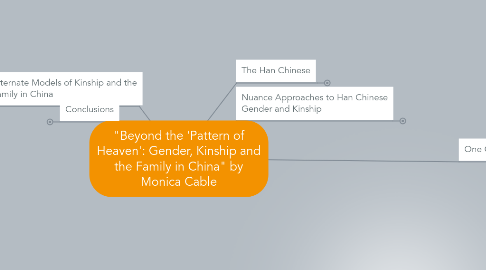
1. Alternate Models of Kinship and the Family in China
1.1. The Dai
1.1.1. bilateral kinship
1.1.1.1. no corporate lineages; lack of surnames that make lineage membership easily identifiable
1.1.2. Matriarchal post marriage residence pattern
1.1.2.1. husbands move into their bride's natal homes for three years, in which the men provide labor for the wife's family
1.2. The Lahu
1.2.1. high degree of gender equality
1.2.1.1. dyadic worldview in which men and women work together in teams
1.2.2. kin terms based on the married couple
1.2.2.1. husband and wife team share the workload in the fields and at home
1.2.2.1.1. husband supports wife in childbirth
1.3. The Mosuo
1.3.1. matrilineal kinship
1.3.1.1. "walking marriage," or tisese
1.3.1.1.1. tisese may be initiated by man or woman; both have right to refuse
1.3.2. distinct sexual division of labor
1.3.2.1. headed by male and female pair
1.3.2.1.1. children belong to the household in which they are born
2. Conclusions
2.1. Striking differences in different societies
2.2. Although the Han are the majority, the remaining populations account for over 100 million people
2.3. There is a need to move beyond the strict patrilineal interpretations based on the Han traditions and develop a more nuanced understanding of gender, kinship, and the family in China
3. The Han Chinese
3.1. Male Centric Kinship System
3.2. Confucianism
3.2.1. people, mainly men, join through self cultivation
3.3. Patrilineal Kinship
3.3.1. Filial Piety
3.3.1.1. children of both sexes honor their father and mother equally
3.3.1.1.1. benevolence on the part of superior and obedience by the inferior
3.3.2. patterned to cement male hegemony
3.3.2.1. major factor in the low status of Han Chinese women
3.4. The Surname
3.4.1. strict rules on the patriarchal side, but not on mother's side
3.4.2. Life Stages of the Han Chinese women
3.4.2.1. extremely inferior position
3.4.2.1.1. from birth; should defer to men throughout their lifespan
4. Nuance Approaches to Han Chinese Gender and Kinship
4.1. Objections
4.1.1. from male centric historical records; variations may indicate that women better position
4.2. Wolf
4.2.1. Uterine family
4.2.1.1. mother centered family unit that could serve to support women cut off from their natal kin networks
4.2.2. Mothers and their children
4.2.2.1. by focusing her efforts on her uterine family, and woman may create a future source of influence and security
4.2.2.1.1. still heavily dependent on sons
4.3. Stafford
4.3.1. role of both parents
4.3.2. Han Chinese kinship is a complex system of mutual responsibility between parents and children
4.4. Post 1949 Trends
4.4.1. People's Republic
4.4.1.1. CCP policies strengthened the traditional Chinese family
4.4.1.1.1. government assistance increase lifespan, providing expanded networks of kin
4.4.2. Constitution 1950
4.4.2.1. outlawed betrothal and concubinage and granted women the right to divorce
4.4.2.1.1. no ancestral worship
5. One Child Policy
5.1. greatly affected the male female ratio
5.1.1. selective abortions
5.1.1.1. increase in the trafficking of women
5.1.1.1.1. serious consequences on social security; increased burden of adult care
